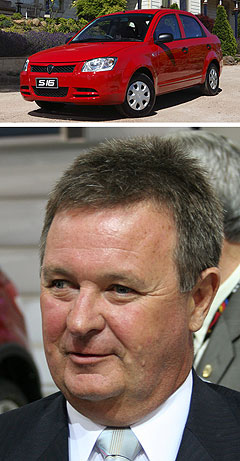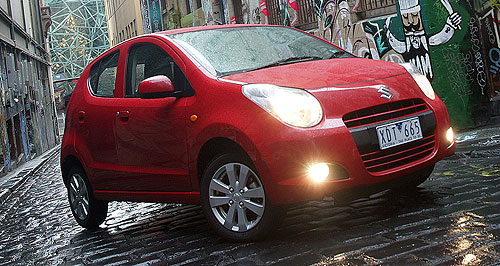Make / Model Search
News - General NewsRumblings on ‘clunkers’ moveFirst in line: Suzuki's $12,990 Alto is likely to benefit from the $2000 cash-for-clunkers proposal. Many in auto industry question effectiveness of $2000 bounty on old trade-ins3 Aug 2010 THE Australian automotive industry’s mixed reaction to the Gillard government’s proposed $394 million ‘cash for clunkers’ scheme continued over the past week, with budget car brands Suzuki and Proton urging the $2000 incentive be increased and the Victorian Automobile Chamber of Commerce (VACC) branding it an exercise in political spin. While all car-makers and industry groups contacted by GoAuto were supportive of the quest to rid Australian roads of inefficient and less safe old cars, most were unsure if the proposed scheme would be effective. The Australian Automotive Aftermarket Association (AAAA) said the scheme would hurt the local parts industry and questioned whether it would reduce greenhouse emissions. In contrast, the Australian Automobile Association (AAA) said it fully supported the initiative, and urged other parties to introduce similar schemes. The federal government’s proposed ‘cleaner car rebate’ is a key part of its re-election campaign and would offer $2000 for motorists to trade-in a pre-1995 model (for wrecking) and purchase a new car with a CO2 emissions rating of 220g/km or less. As GoAuto reported last week, there is unease among some in the industry about the scheme because of the lack of locally produced models that qualify and the potential for motorists to be steered towards only low-cost imported models. Using that logic, Suzuki Australia, which sells one of Australia’s cheapest cars, the $12,990 (driveaway) Alto, would likely be a major beneficiary.  Left: Proton S16. Below: Suzuki Australia's Tony Devers. Left: Proton S16. Below: Suzuki Australia's Tony Devers.However, Suzuki Australia general manager Tony Devers told GoAuto this week that the Gillard plan did not provide enough incentive for motorists to upgrade to a new vehicle. “$2000 isn’t enough,” Mr Devers said. “That is the key issue. “The Alto is $12,990, is very efficient and has six airbags, but after the grant they (potential customers) would still need to find another $11,000. “If you look at the people driving cars that are worth less than $2000, what percentage of them would be able to spend enough to upgrade to a new car? It would be very, very low.” Mr Devers said that if an Australian federal government wanted to make a big difference, it would offer a scrappage incentive of $5000, like in the US and Germany. “If they are serious they should provide that kind of incentive,” he said. “There are has to be some kind of significant new-car bonus for cars with real safety and environmental credentials.” Proton Cars Australia managing director John Startari told GoAuto he agreed with the conclusion that those who would qualify for the grant were unlikely to be able to afford to purchase a new car with such an incentive. “If they received the $2000 on top of what they would get for a trade-in, that would actually make a difference,” he said. “A lot of people who might benefit from such a scheme are driving cars that would get $5000 as a trade-in, so it wouldn’t make sense for them to hand their car over for $2000.” VACC executive director David Purchase said he had his doubts about the Gillard scrappage scheme, which forms a key part of the Labor party’s re-election bid. “I’m inclined to think that this is more about spin and being seen to be doing something for the environment than actually getting inefficient and unsafe cars off the road,” he said. Mr Purchase said the VACC supported getting old vehicles off the road. “Our research shows that about 30 per cent of vehicles are unroadworthy, so anything that gets some of them off the road gets our support,” he said. However, Mr Purchase doubted the scheme would have much of an effect. “If you have a clunker, you are not financially well off and $2000 is not going to enable you to buy a new car. It is likely that the $2000 is going to go to someone who was going to buy a new car anyway.” Mr Purchase said introducing stricter roadworthy inspections would be far more effective in removing older, unsafe and inefficient cars from Australian roads. As Australia’s peak automotive aftermarket body, the AAAA has made it clear that it does not support the Gillard policy. AAAA executive director Stuart Charity branded the scheme as a bad policy, arguing that it was unlikely to reduce greenhouse gas emissions and would hurt the Australian car industry. “As the market already provides an incentive for purchasing a new vehicle via a trade-in, we are at a loss to understand how the Australian government funding this program will change consumer behaviour,” he said. “There is little doubt that the highly margin-sensitive car dealership industry will factor this incentive into their car pricing. The price of eligible new vehicles will simply rise by $2000 in 2011.” Mr Charity said the fact that only one locally made vehicle currently qualified under the scheme would hurt the local new-car and component manufacturing industry. “The only segment of the automotive industry that benefits from this scheme is new-car importers and dealers,” he said. “The government has overlooked two other critical industry segments – the vehicle and component manufacturers and the aftermarket parts, service and repair segments.” Prime minister Gillard’s plan was given some support by the AAA, the national body representing the various state motoring groups such as the NRMA and RACV. “AAA and the constituent clubs welcome this announcement as it will also encourage Australians into vehicles with significantly upgraded safety equipment than vehicles which were made prior to 1995,” said AAA chief executive Mike Harris. "AAA and the constituent clubs support this announcement and call on other parties to introduce similar programs.” Mr Harris said the introduction of the scrappage scheme would bring Australia into line with international efforts to reduce vehicle emissions. “Incentives to encourage people out of less efficient cars into cleaner, more efficient vehicles and engines are a major part of the climate change challenge for Australian motorists and the community,” he said.  Read more |
Click to shareGeneral News articlesResearch General News Motor industry news |










Facebook Twitter Instagram